Watts Naval Training School, Dereham, Norfolk
It had long been Thomas Barnardo's ambition to establish his own naval training school. The opportunity to make this a reality arose in 1899 when a fee-paying County School at North Elmham near Dereham in Norfolk folded and the property was put up for sale. Barnardo inspected the premises and could quite understand why the school had failed to attract pupils — it lacked a heating system and baths and has no fire escapes despite being lit by oil lamps. Nonetheless, Barnardo was convinced of the site's suitability for conversion to a nautical training establishment. However, with his organisation already over-stretched financially, there seemed no prospect of finding the funds to acquire the property. The answer to his prayers came in the shape of Mr Edmund Hannay Watts, head of the British Steamship Company. Barnardo convinced Watts of the value of the enterprise which would not only benefit hundreds of underprivileged boys, but also contribute to the manpower of the Royal Navy. Watts eventually agreed to fund the purchase of the site and its alterations to the tune of over £10,000. The new school, named the Watts Naval Training School in honour of its benefactor, had boys in residence by 1903. However, the official opening ceremony did not take place until April 1906, an occasion that neither Barnardo nor Watts lived to witness.
The location of the home is shown on the 1906 map below.

Watts Naval Training School site, Dereham, c.1906.
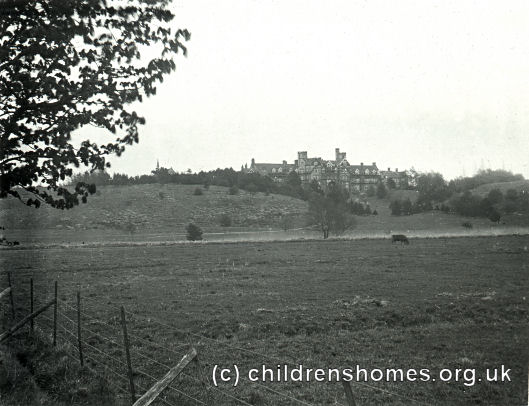
Watts Naval Training School from the north-west, c.1906. © Peter Higginbotham
The school could accommodate around 300 boys aged 10 to 14 (later 13 to 16). The main building was organised like a large ship with various 'decks' and a 'bridge' — a central balcony. The improvements instigated by Barnardo — a heating system, hot water, fire escapes from the upper floors, and many renovations and improvements to the buildings and grounds — made life considerably more bearable than that experienced by the school's former well-to-do residents. Nonetheless, conditions at the school were far from comfortable for its new generation of inmates. The daily routine began with 'Reveille' at 5.45am when the boys rose, dressed, and made their beds. At 5.59am precisely, a bugle sounded to signal a minute of prayers with the boys kneeling by their beds. A further bugle-call then marked the start of 45 minutes 'clean ship' tasks such as sweeping and scrubbing floors and polishing, perhaps with a short cross-country run thrown in. Breakfast, at 6.45am, comprised two thick slices of bread and dripping and cocoa served in a tin basin. After more cleaning duties, there was a parade-ground assembly for an inspection of clothing and boots. The latter were only worn in the winter months and from March to October the boys went around in bare feet, even during activities such as football. After the ceremonial raising of flags, prayers and the singing of hymns and the national anthem, lessons began. These lasted from 10am until 5pm, with a break for dinner. As well as being taught schoolwork or instructed in seamanship, the boys might also be assigned 'special duties' — providing labour in areas such as the kitchen, laundry or bakehouse. After a light tea at 5pm, the boys had a period of recreation time when, according to the weather they could play outside, read donated books or magazines, or play indoor games such as draughts or chess. At 7pm, there was more cocoa and a helping of broken ship's biscuits. Bedtime preparations included the brushing of teeth with salt and a gargle in salt water. The weekly bath night included a physical inspection of all the boys, arms above their heads, before they were allowed to return to their dormitories. After 'Last Post' at 8.45pm, there was a minute's silent bedside prayer, with lights-out at 9pm.
The main building is shown below — the new fire escapes specified by Barnardo are clearly visible.

Watts Naval Training School entrance, c.1906. © Peter Higginbotham
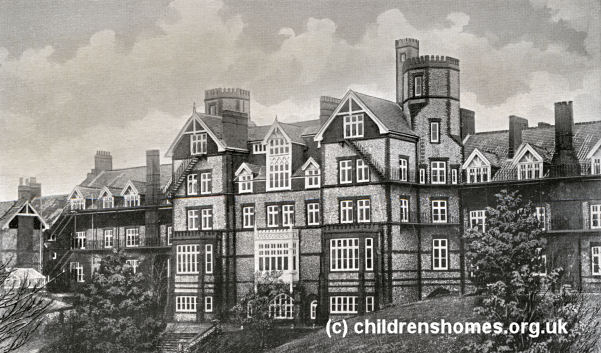
Watts Naval Training School from the south-west, c.1906. © Peter Higginbotham
The food provided at the school left much to be desired. The soup served for dinner on three days a week was described by one boy as 'a thick, muddy mixture of bones and chunks of meat with plenty of fat and gristle on it. The middle section was clearer while on top, for a good quarter of an inch, was green grease', (Rose, 1987). For those who managed to down their soup, there was a second course of 'ni**ers in the snow' — boiled rice with a few currants in to sweeten it. [Despite the purely historical context, Google consider that the name given to the latter dish to be too offensive to include in full here.]
Punishments for those breaking the school's rules were graded in severity, with minor offenders having to stand 'on deck' for thirty minutes and the most serious wrongdoers receiving up to six strokes with a cane on the bare buttocks. Such punishments were carried out in front of the whole school.
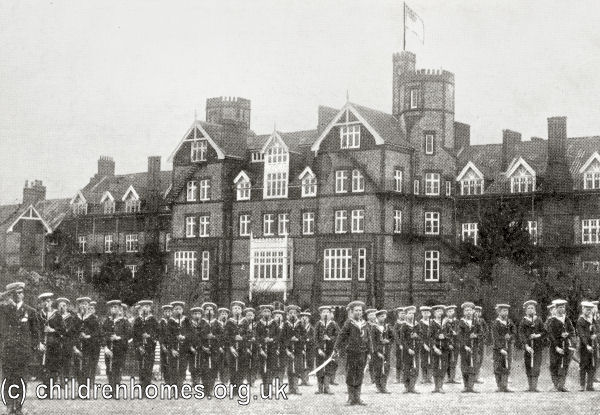
Watts Naval Training School — cadets on parade, date unknown. © Peter Higginbotham
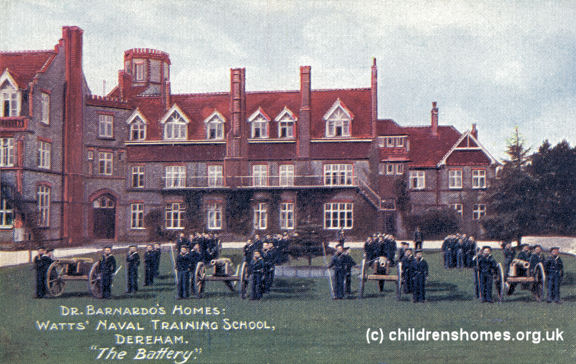
Watts Naval Training School — naval battery display, date unknown. © Peter Higginbotham
Contact with home was restricted with letters in each direction being censored. From 1924, increasing concern about the unsettling effect on the boys from visits home at Christmas resulted in the introduction of a ban on such trips.
Despite the tough regime, an endorsement of the education provided at WNTS (as the school was sometimes referred to) was supplied by the Admiralty's £25 gratuity for each Watts boy joining the Royal Navy and scoring more than 60 per cent in a set of 'Advanced Class' tests. At one stage, more than £12,000 had accumulated to the school through this scheme.
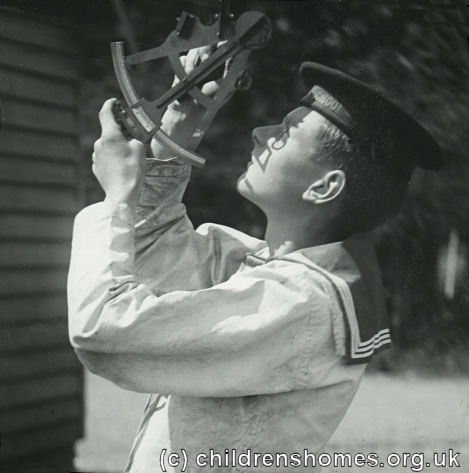
Watts Naval Training School — using a sextant. © Peter Higginbotham
The School had its own training ship, the George L. Munro, which was stationed at Great Yarmouth and cruised around the Norfolk coast.

Watts officers' and boys aboard the George L Munro. © Peter Higginbotham
Watts boys played a notable part in the First World War, with a total of 566 serving in the forces of whom 44 were killed.
The home closed in 1953, with the boys being transferred to the William Baker Technical School at Hertford, which had previously served as Barnardo's training school for the merchant navy.
Virtually all the Watts school buildings have been demolished although the former chapel still survives, now a private residence.
Records
Note: many repositories impose a closure period of up to 100 years for records identifying individuals. Before travelling a long distance, always check that the records you want to consult will be available.
- Barnardo's 'Making Connections' and Family History Services — for enquiries relating the records of children formerly in the care of Barnardo's and those of other organisations absorbed by them.
Bibliography
- Barnardo, Syrie Louise, and Marchant, James Memoirs of the Late Dr Barnardo (Hodder & Stoughton, 1907)
- Batt, J.H. Dr. Barnardo: The Foster-Father of "Nobody's Children" (S.W. Partridge, 1904)
- Bready, J. Wesley Doctor Barnardo (Allen & Unwin, 1930)
- Higginbotham, Peter Children's Homes: A History of Institutional Care for Britain's Young (2017, Pen & Sword)
- Rose, June For the Sake of the Children: Inside Dr. Barnardo's: 120 years of caring for children (Hodder & Stoughton, 1987)
- Wagner, Gillian Barnardo (Weidenfeld & Nicholson, 1979)
Links
- The Barnardo's website.
- The Goldonian Website — memories and information from former Barnardo's children.
Except where indicated, this page () © Peter Higginbotham. Contents may not be reproduced without permission.


